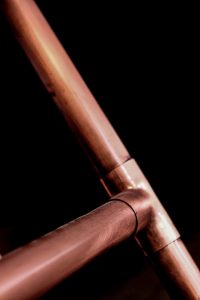
There are over 90 metallic elements listed on the Periodic Table. While no two metals are the same, they can all be classified as either ferrous or non-ferrous depending on whether they contain iron. Ferrous metals contain iron, whereas non-ferrous metals don’t contain iron. Below are five of the most common types of non-ferrous metals.
#1) Copper
Copper is a non-ferrous metal that’s used in countless consumer and commercial applications. It’s strong, durable and highly conductive. The conductive properties of copper, in fact, make it ideal for use in electrical applications. Printed circuit boards (PCBs) and wires are often made of copper. Unlike with other metals, electricity can easily flow through copper.
#2) Aluminum
Another common type of non-ferrous metal is aluminum. Aluminum is prized for its lightweight properties. It weighs about one-third less than steel. Even with its lightweight properties, aluminum is still strong and durable. From aerospace components to automotive engines, fasteners and cooking pots, aluminum is used to make a variety of products. Aluminum doesn’t contain any significant amount of iron, so it’s classified as a non-ferrous metal.
#3) Nickel
We can’t talk about non-ferrous metals without mentioning nickel. Featuring the atomic number 28, it’s a common non-ferrous metal with a silver color and a gold tint. What is nickel used for exactly? One of the most common applications for nickel is the production of iron alloys. Iron alloys, of course, are metal compounds consisting primarily of iron with one or more secondary metals. Stainless steel, for instance, contains iron and nickel. Even carbon steel often contains nickel. Along with iron alloys, nickel is used in batteries, fuel cells and electronics.
#4) Tin
There’s also the non-ferrous metal tin. Tin is a metallic element with the atomic number 50. Like nickel, it has a silver color. With that said, tin is much softer than nickel. While nickel is relatively strong and durable, tin is more malleable. This makes it easier to bend than its nickel counterpart. Tin was originally used for food wrap. Around the turn of the 20th century, though, it was replaced with aluminum. Most food wrap is now made of aluminum.
#5) Zinc
Finally, zinc is a common type of non-ferrous metal. It’s a silver-colored metal that’s known to tarnish when exposed to air. Exposure to air triggers oxidation. With oxidation, a chemical reaction occurs that results in tarnishing. Nonetheless, zinc is still useful for many applications. Zinc is used specifically for galvanization. Metals like iron, as well as iron alloys, can be galvanized with zinc. Galvanization will create a protective barrier over the metal so that it’s resistant to corrosion.
